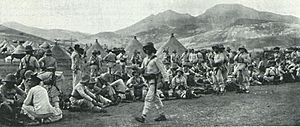Kert campaign facts for kids
Quick facts for kids Kert Campaign |
|||||||||
|---|---|---|---|---|---|---|---|---|---|
| Part of the Spanish-Moroccan conflicts and Scramble for Africa | |||||||||
 Spanish camp near the Kert River in October 1911. |
|||||||||
|
|||||||||
| Belligerents | |||||||||
| Commanders and leaders | |||||||||
| Units involved | |||||||||
| Spanish Army Regulares |
Riffian harkas | ||||||||
| Casualties and losses | |||||||||
| 500 killed 1,900 wounded |
Unknown | ||||||||
The Kert campaign (called campaña del Kert in Spanish) was a conflict in northern Morocco. It happened between Spain and local Riffian tribes. These tribes were led by Mohammed Ameziane. He called for a jihad (a holy struggle) against the Spanish presence. The campaign took place from 1911 to 1912.
Contents
What Was the Kert Campaign?
This campaign was part of a bigger period called the Scramble for Africa. During this time, European countries like Spain were trying to control parts of Africa. The Kert Campaign was about Spain trying to secure its control in the eastern Rif region of Morocco.
New Troops Join the Fight
During this campaign, a new type of soldier was introduced. These were the tropas regulares indígenas, which means "native regular troops." They were created by Dámaso Berenguer on June 30, 1911. These troops were made up of local people who were trained and led by Spanish officers.
How the Conflict Started
The conflict began because of a revolt led by Mohammed Ameziane. He was a local leader, known as a caïd, from Segangan. Ameziane encouraged the local tribes to fight against the Spanish. He also attacked tribes who were friendly with Spain.
On August 24, 1911, the Spanish campaign officially started. This was after Ameziane's forces attacked a group of Spanish soldiers. These soldiers were working on mapping the area near Ishafen, close to the Kert River. However, Spanish troops had already faced attacks as early as June 30.
Key Events and Battles
On October 7, 1911, Agustín Luque, who was Spain's War Minister, visited Melilla. After his visit, he took charge of the military operations. The fighting was intense and both sides suffered many losses. For example, on the Spanish side, 64 soldiers died and 204 were wounded.
A tough day for the Spanish was October 14, 1911. General Salvador Díaz Ordóñez was killed in action. A column of soldiers led by General Navarro also suffered heavily. They had 33 deaths and 105 wounded.
On January 18, 1912, Spanish forces managed to capture a key position. This was the area known as Al Aaroui, or Monte Arruit.
The End of the Campaign
The Kert Campaign came to an end on May 15, 1912. This was after Mohammed Ameziane was killed by the native Regulares troops. By this time, Spain had lost about 500 soldiers and 1,900 were wounded.
After the campaign, Spain extended its control. The Spanish-controlled area now reached the Kert River. This also meant that the Berber tribes of Ait Sidel and Ait Bu-Gafar became part of the Spanish territory.
See also
 In Spanish: Campaña del Kert para niños
In Spanish: Campaña del Kert para niños
- Tetuán War
- First Melillan campaign
- Second Melillan campaign


